Roselle, Rosella
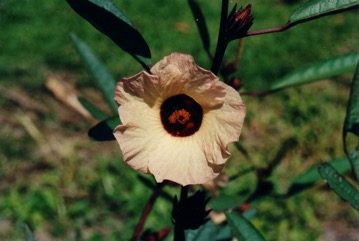
A tropical plant. It grows from sea level up to about 1,700 m altitude. It will tolerate a range of soils. It requires short days for flowering. They will grow in semi arid locations. It grows best where average temperatures are in the range 25-30°. It needs a temperature above 10-13°C. It is very sensitive to frost. Plants will tolerate high temperatures. They grow up to 800 m altitude in Africa. A rainfall of 450-550 mm distributed over a 90-120 day growing period is required. It cannot tolerate waterlogged soils. It can grow in arid places. It suits hardiness zones 10-12. In XTBG Yunnan.
Also known as:
Abema, Abin kan iyaakaa, Amukan, Ankpama, Asam ruso, Asam susur, Bamya, Bare-see, Beet, Bilat-chinbaung, Bissap, Carcade, Cay bup giam, Chidede, Chinbaung-ni, Chinbaung ywet, Chinebaune, Chukar, Chukiar, Divay, Ekiganga, Ekikenke, Emalakany, Emelakwang, Fol-lere, Folere, Florida cranberry, Gamet walanda, Gisima, Gisma, Gurguzu, Hanserong, Hasip, Indian sorrel, Jajewdet, Kahcieb priew, Kalabi, Karcade, Karkady, Ka-santhor, Kasturi roriha, Kata bahaji petua, Khatabhaji, Khirmoishak, Kpakpala, Krachiap-daeng, Krachiap, Kubab, Kudiass, Kuluba, Labog, Lakher-anthur, Lal-ambadi, Lal-ambari, Lal mesta, Lal-mista, Langkamit, Lokeke, Malakwang, Mei gui qie, Mesta tenga, Mphesya, Ngayi-ngayi, Ojo, Oseilla rouge, Oseille, Patwa, Phakkengkheng, Phat-swon-pan, Polechi, Pulichchai, Pulincha kira, Pundibija, Quimbombo chino, Rata bilincha, Red Sorrel, Roozera, Rosel, Rosela, Sakpa, Sangume, Sato, Sawa-sawa, Shan qie zi, Shilot sougree, Slok chu, Sodo, Som pho di, Sorel, Sour-sour, Sum-bawng, Sununkru, Sure, Talingsiag, Tenga more, Thakhlao maikhri, Tikonn'te, Tikwouann'ti, Tropical cranberry, Vaianthuh, Vai anthuk, Vinagreira, Yakuwa, Yakwa, Yerra gogu
Synonyms
- Abelmoschus sabdariffa
- Furcaria sabdariffa Ulbr.
- Hibiscus cannabinus Hiern.
- ? Hibiscus masuianus De Wild. & T. Durand
- ? and others
Edible Portion
- Calyces, Leaves, Seeds, Flowers - tea, Vegetable, Fruit
Where does Roselle grow?
Found in: Africa, Amazon, Andamans, Angola, Antigua and Barbuda, Asia, Australia, Bangladesh, Benin, Brazil, Burkina Faso, Burundi, Cambodia, Cameroon, Central Africa, Central African Republic, CAR, Central America, Chad, China, Congo DR, Congo R, Costa Rica, Côte d'Ivoire, Cuba, Dominica, Dominican Republic, East Africa, East Timor, Egypt, Equatorial-Guinea, Ethiopia, Fiji, Gabon, Gambia, Ghana, Grenada, Guatemala, Guiana, Guianas, Guinea, Guinée, Guinea-Bissau, Guyana, Haiti, Hawaii, Himalayas, India, Indochina, Indonesia, Ivory Coast, Jamaica, Kenya, Laos, Madagascar, Malawi, Malaysia, Mali, Mauritania, Mauritius, Mexico, Mozambique, Myanmar, Namibia, Nepal, Nicaragua, Niger, Nigeria, North Africa, North America, Northeastern India, Pacific, Pakistan, Panama, Papua New Guinea, PNG, Philippines, Rotuma, Rwanda, Sao Tome and Principe, Saudi Arabia, SE Asia, Senegal, Seychelles, Sierra Leone, Singapore, Slovenia, Somalia, South Africa, Southern Africa, South America, South Sudan, Spain, Sri Lanka, Sudan, Suriname, Taiwan, Tanzania, Thailand, Timor-Leste, Togo, Tonga, Uganda, United States, Vanuatu, Venezuela, Vietnam, West Africa, West Indies, Zambia, Zimbabwe
Notes: There are about 220 Hibiscus species. Chemical composition (calyx): Protein (crude) = 10.9% (dry). Fat = 1.1% (dry). Fibre (crude) = 10.7% (dry). Ash (insoluble) = 11.5% (dry). Carbohydrate (soluble): Starch = 2.8% (dry). Sucrose = Ø %. D-glucose = 3.5% (dry). D-fructose = 0.9% (dry). Amino acids (g [16g N]-1): Aspartic acid = 39.0g. Threonine = 1.8g. Serine = 2.0g. Glutamic acid = 6.9g. Proline = 3.9g. Glycine = 2.4g. Alanine = 2.4g. Valine = 2.4g. Cysteine = 0.3g. Methionine = 0.7g. Isoleucine = 2.0g. Leucine = 3.0g. Tyrosine = 1.1g. Lysine = 2.6g. Phenylalanine = 1.7g. Lysine = 2.6g. Histidine = 1.5g. Arginine = 2.5g. Minerals: Sulphur = 0.13% (dry). Potassium = 0.13% (dry). Magnesium = 0.33% (dry). Calcium = 1.29% (dry). Na = 0.01% (dry). K = 2.53% (dry). Zinc = 41 mg/kg-1 (dry). Iron = 97 mg/kg-1 (dry). Manganese = 416 mg/kg-1 (dry). Copper = 5 mg/kg-1 (dry). Aluminium = 66 mg/kg-1 (dry).
Status: It is a commercially cultivated vegetable. The leaves and flowers are sold in markets in India. In Papua New Guinea, not common except in areas where people have been encouraged to grow it. eg Sepik. Leaves are sold in local markets. They are commonly eaten in Senegal.
Growing Roselle, Rosella
Cultivation: Seeds are sown and the seedlings can be transplanted. They are transplanted when 15-20 cm high. Seed should be planted 1-2.5 cm deep. A spacing of 50 cm x 50 cm is suitable although a wider spacing is used for fruit and a closer one for leaves. Plants can be propagated by cuttings.
Edible Uses: The swollen bases of the flowers are used for jams or drinks. The young leaves can be cooked and eaten. They can also be dried and used later. The flowers can be used to flavour drinks. The seeds can be eaten. They can be dried and ground. They can be pressed for oil. They are also fermented. The dried ground seeds are used for coffee.
Production: Fruit are ready 12-15 weeks after sowing. The bracts are picked 15-20 days after flowering. They can produce about 1 kg per plant. The yield of leaves can be 10 tons per hectare. Young leaves are plucked from the plant.
Nutrition Info
per 100g edible portion| Edible Part | Energy (kcal) | Protein (g) | Iron (mg) | Vitamin A (ug) | Vitamin c (mg) | Zinc (mg) | % Water |
|---|---|---|---|---|---|---|---|
| Leaves | 44 | 10.9 | 1.5 | 58 | 35 | 4.1 | 86.4 |
| Seeds | 411 | 19.6 | 4.2 | - | - | - | 8.2 |
| Flowers | - | - | - | - | - | - | |
| Calyces | 44 | 1.6 | 3.8 | 29 | 14 | - | 86 |
Roselle, Rosella Photos

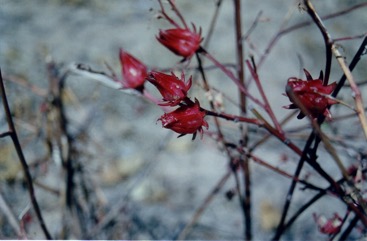
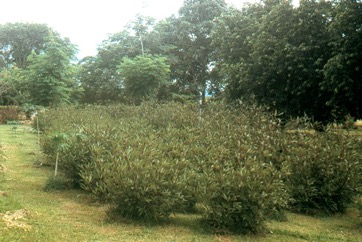
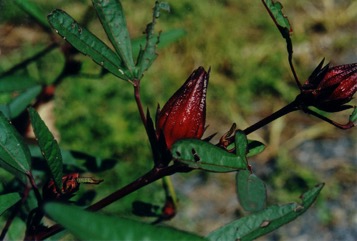
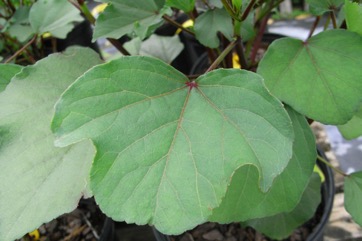
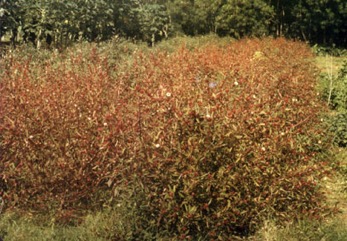
References
Roselle references Hibiscus sabdariffa
ABDELMUTI,
Achigan-Dako, E, et al (Eds), 2009, Catalogue of Traditional Vegetables in Benin. International Foundation for Science.
Agea, J. G., et al 2011, Wild and Semi-wild Food Plants of Bunyoro-Kitara Kingdom of Uganda: etc. Environmental Research Journal 5(2) 74-86
Alice, L. & O'Quinn, T., Australian Bush Superfoods. Explore Australia p 138
Altschul, S.V.R., 1973, Drugs and Foods from Little-known Plants. Notes in Harvard University Herbaria. Harvard Univ. Press. Massachusetts. no. 2756
Ambasta, S.P. (Ed.), 2000, The Useful Plants of India. CSIR India. p 267
Anderson, E. F., 1993, Plants and people of the Golden Triangle. Dioscorides Press. p 212
Arora, R. K., 2014, Diversity in Underutilized Plant Species - An Asia-Pacific Perspective. Bioversity International. p 103
Batawila, K., et al, 2007, Diversite et gestion des legumes de cueillete au Togo. African Journal of Food, Agriculture, Nutrition and Development 7( 3& 4): 66
Bernholt, H. et al, 2009, Plant species richness and diversity in urban and peri-urban gardens of Niamey, Niger. Agroforestry Systems 77:159-179
Bodkin, F., 1991, Encyclopedia Botanica. Cornstalk publishing, p 558
Borrell, O.W., 1989, An Annotated Checklist of the Flora of Kairiru Island, New Guinea. Marcellin College, Victoria Australia. p 97, 196
Boulanger, J., 1989, In Rehm. S. (Ed.) Handbook of agriculture and nutrition in underdeveloped countries. Vol. 4. Special plant cultivation in the tropics and subtropics. 2nd ed. Eugen Ulmer, Stuttgart, Germany pp. 568-573.
Bourke, R. M., Altitudinal limits of 230 economic crop species in Papua New Guinea. Terra australis 32.
Bremness, L., 1994, Herbs. Collins Eyewitness Handbooks. Harper Collins. p 107
Brouk, B., 1975, Plants Consumed by Man. Academic Press, London. p 137, 319
Brown, D., 2002, The Royal Horticultural Society encyclopedia of Herbs and their uses. DK Books. p 235
Burkill, H. M., 1985, The useful plants of west tropical Africa, Vol. 4. Kew.
Burkill, I.H., 1966, A Dictionary of the Economic Products of the Malay Peninsula. Ministry of Agriculture and Cooperatives, Kuala Lumpur, Malaysia. Vol 1 (A-H) p 1189
Catarino, L. et al, 2019, Edible Leafy Vegetables from West Africa (Guinea-Bissau): Consumption, Trade and Food Potential. Foods 2019, 8, 493
Cisse, M. et al, 2009, Le bissap (Hibiscus sabdariffa L.): composition et principles utilisations. Fruits, Vol. 64, p 179-193
Coronel, R.E., 1982, Fruit Collections in the Philippines. IBPGR Newsletter p 10
Dalziel, J. M., 1937, The Useful plants of west tropical Africa. Crown Agents for the Colonies London.
Dansi, A., et al, 2008, Traditional leafy vegetables and their use in the Benin Republic. Genet Resour Crop Evol (2008) 55:1239–1256
Devi, O.S., P. Komor & D. Das, 2010, A checklist of traditional edible bio-resources from Ima markets of Imphal Valley, Manipur, India. Journal of Threatened Taxa 2(11): 1291-1296
Diouf, M., et al, Leafy Vegetables in Senegal. Bioversity webite
Engel, D.H., & Phummai, S., 2000, A Field Guide to Tropical Plants of Asia. Timber Press. p 188
Epenhuijsen C.W. van., 1974, Growing Native vegetables in Nigeria. FAO Rome, p 68
Facciola, S., 1998, Cornucopia 2: a Source Book of Edible Plants. Kampong Publications, p 148
FAO, 1988, Traditional Food Plants, FAO Food and Nutrition Paper 42. FAO Rome p 328
Flora of China. www.eFloras.org
Flora of Pakistan. www.eFloras.org
Flowerdew, B., 2000, Complete Fruit Book. Kyle Cathie Ltd., London. p 112
Food Composition Tables for use in Africa FAO http://www.fao.org/infoods/directory No. 793
Fowler, D. G., 2007, Zambian Plants: Their Vernacular Names and Uses. Kew. p 46
Fox, F. W. & Young, M. E. N., 1982, Food from the Veld. Delta Books. p 262
Freiberger, C. E., et al, 1998, Nutrient content of the edible leaves of seven wild plants from Niger. Plant Foods for Human Nutrition 53: 57–69
French, B.R., 1986, Food Plants of Papua New Guinea, A Compendium. Asia Pacific Science Foundation p 269
Gangte, H. E., et al, 2013, Wild Edible Plants used by the Zou Tribe in Manipur, India. International Journal of Scientific and Research Publications, Volume 3, Issue 5
Glew, R. H., et al, 1997, Amino Acid, Fatty Avid and Mineral Composition of 24 Indigenous Plants of Burkina Faso. Journal of Food Composition and Analysis 10, 205-217
Godfrey, J. et al, 2013, Harvesting, preparation and preservation of commonly consumed wild and semi-wild food plants in Bunyoro-Kitara Kingdom, Uganda. Int. J. Med. Arom. Plants. Vol.3 No.2 pp 262-282
Godfrey, J., et al, 2013, Market Structure of Wild and Semi-Wild Food Plants Traded in Bunyoro-Kitara Kingdom, Uganda. Int. J. Med. Arom. Plants. Vol. 3 No. 2 pp 300-316
Goode, P., 1989, Edible Plants of Uganda. FAO p 30
Goode, P., 1989, Edible Plants of Uganda. FAO p 36
Goode, P., 1989, Edible Plants of Uganda. FAO p 39
Grubben, G. J. H. and Denton, O. A. (eds), 2004, Plant Resources of Tropical Africa 2. Vegetables. PROTA, Wageningen, Netherlands. p 321
Guite, C., 2016, A study of wild edible plants associated with the Paite tribe of Manipur, India, International Journal of Current Research. Vol. 8, Issue, 11, pp. 40927-40932
Harris, F. M. A. and Mohammed, S., 2003, Relying on Nature: Wild Foods in Northern Nigeria. Ambio Vol. 32 No. 1. p 25-30
Hiddins, L., 1999, Explore Wild Australia with the Bush Tucker Man. Penguin Books/ABC Books. p 155
Hossain, U. & Rahman, A., 2018, Study and quantitative analysis of wild vegetable floral diversity available in Barisal district, Bangladesh. Asian J. Med. Biol. Res. 2018, 4 (4), 362-371
Hussey, B.M.J., Keighery, G.J., Cousens, R.D., Dodd, J., Lloyd, S.G., 1997, Western Weeds. A guide to the weeds of Western Australia. Plant Protection Society of Western Australia. p 174
Hu, Shiu-ying, 2005, Food Plants of China. The Chinese University Press. p 540
Jacquat, C., 1990, Plants from the Markets of Thailand. D.K. Book House p 70
Japanese International Research Centre for Agricultural Science www.jircas.affrc.go.jp/project/value_addition/Vegetables
Jardin, C., 1970, List of Foods Used In Africa, FAO Nutrition Information Document Series No 2.p 43, 82
John, L., & Stevenson, V., 1979, The Complete Book of Fruit. Angus & Robertson p 260
Kar, A., et al, 2013, Wild Edible Plant Resources used by the Mizos of Mizoram, India. Kathmandu University Journal of Science, Engineering and Technology. Vol. 9, No. 1, July, 2013, 106-126
Katz, E., et al, 2012, No greens in the forest? Note on the limited consumption of greens in the Amazon. Acta Soc Bot Pol 81(4):283–293
Kays, S. J., and Dias, J. C. S., 1995, Common Names of Commercially Cultivated Vegetables of the World in 15 languages. Economic Botany, Vol. 49, No. 2, pp. 115-152
Kenneally, K.E., Edinger, D. C., and Willing T., 1996, Broome and Beyond, Plants and People of the Dampier Peninsula, Kimberley, Western Australia. Department of Conservation and Land Management. p 123
Khodram,S. D., et al, 2019, Local knowledge of edible flowers used in Mizoram. Indian Journal of Traditional Knowledge Vol 18(40 pp 715-723
Kiple, K.F. & Ornelas, K.C., (eds), 2000, The Cambridge World History of Food. CUP p 1844
Lazarides, M. & Hince, B., 1993, Handbook of Economic Plants of Australia, CSIRO. p 132
Leger, S., 1997, A Description of Today's Use of Plants in West Bushmanland (Namibia). German Development Service. PO Box 220035, 14061 Berlin, Germany. http://www.sigridleger.de/book/
Liu, Yi-tao, & Long, Chun-Lin, 2002, Studies on Edible Flowers Consumed by Ethnic Groups in Yunnan. Acta Botanica Yunnanica. 24(1):41-56
Llamas, K.A., 2003, Tropical Flowering Plants. Timber Press. p 257
Low, T., 1991, Wild Food Plants of Australia. Australian Nature FieldGuide, Angus & Robertson. p 144
Luczaj, L., et al, 2021, Wild food plants and fungi sold in the markets of Luang Prabang, Lao PDR. Journal of Ethnobiology and Ethnomedicine (2021) 17:6
Lugod, G.C. and de Padua L.S., 1979, Wild Food Plants in the Philippines. Vol. 1. Univ. of Philippines Los Banos. p 50
Lykke, A. M., Mertz, O, and Ganaba, S., 2002, Food Consumption in Rural Burkina Faso, Ecology of Food and Nutrition, 41:119-152
Lyle, S., 2006, Discovering fruit and nuts. Land Links. p 238
Macmillan, H.F. (Revised Barlow, H.S., et al) 1991, Tropical Planting and Gardening. Sixth edition. Malayan Nature Society. Kuala Lumpur. p 302, 355
Maganha, A. G., et al, 2010, Pharmacological evidences for the extracts and secondary metabolites from plants of the genus Hibiscus. Food Chemistry 118: 1-10
Maghirang, R. G., et al, 2018. Ethnobotanical Studies of Some Plants Commonly Used as Vegetables in Selected Provinces of the Philippines. Journal of Nature Studies. 17(2), 30-43.
Maiga, A., et al, 2005, Determination of Some Toxic and Essential Metal Ions in Medicinal and Edible Plants from Mali. Journal of Agricultural and Food Chemistry 53: 2316-2321
Manandhar, N.P., 2002, Plants and People of Nepal. Timber Press. Portland, Oregon. p 261
Martin, F.W., & Ruberte, R.M., 1979, Edible Leaves of the Tropics. Antillian College Press, Mayaguez, Puerto Rico. p 37, 204
McClintock, N.C. & El Tahir, I.M., 2004. Hibiscus sabdariffa L. [Internet] Record from Protabase. Grubben, G.J.H. & Denton, O.A. (Editors). PROTA (Plant Resources of Tropical Africa), Wageningen, Netherlands. < http://database.prota.org/search.htm>. Accessed 16 October 2009.
McMakin, P.D., 2000, Flowering Plants of Thailand. A Field Guide. White Lotus. p 98
Medhi, P. & Borthakur, S. K., 2012, Phytoresources from North Cachur Hills of Assam -3: Edible plants sold at Hflong market. Indian Journal or Natural Products and Resources. 3(1) pp 84-109
Menninger, E.A., 1977, Edible Nuts of the World. Horticultural Books. Florida p 65
Mertz, O., Lykke, A. M., and Reenberg, A., 2001, Importance and Seasonality of Vegetable Consumption and Marketing in Burkina Faso. Economic Botany, 55(2):276-289
Miguel, E., et al, 1989, A checklist of the cultivated plants of Cuba. Kulturpflanze 37. 1989, 211-357
Morton, J. F., 1987, Fruits of Warm Climates. Wipf & Stock Publishers p 281
Norrington, L., & Campbell, C., 2001, Tropical Food Gardens. Bloomings Books. p 72
Ochse, J.J. et al, 1931, Vegetables of the Dutch East Indies. Asher reprint. p 475
Okigbo, B.N., Vegetables in Tropical Africa, in Opena, R.T. & Kyomo, M.L., 1990, Vegetable Research and development in SADCC countries. Asian Vegetable Research and development Centre. Taiwan. p 44
Omawale, 1973, Guyana's edible plants. Guyana University, Georgetown p 44
Oomen, H.A.P.C., & Grubben, G.J.H., 1978, Tropical Leaf Vegetables in Human Nutrition, Communication 69, Department of Agricultural research, RTI Amsterdam, p 23, 36, 83
Paczkowska, G. & Chapman, A.R., 2000, The Western Australian Flora. A Descriptive Catalogue. Western Australian Herbarium. p 290
Pasha, M. K. & Uddin, S. B., 2019, Minor Edible Fruits of Bangladesh. Bangladesh J. Plant Taxon. 26(2): 299–313
Patiri, B. & Borah, A., 2007, Wild Edible Plants of Assam. Geethaki Publishers. p 14
Pawera, L., et al, 2020, Wild Food Plants and Trends in Their Use: From Knowledge and Perceptions to Drivers of Change in West Sumatra, Indonesia, Foods. 2020, 9, 1240
Peekel, P.G., 1984, (Translation E.E.Henty), Flora of the Bismarck Archipelago for Naturalists, Division of Botany, Lae, PNG. p 363, 362
Peters, C. R., O'Brien, E. M., and Drummond, R.B., 1992, Edible Wild plants of Sub-saharan Africa. Kew. p 145
Pham-Hoang Ho, 1999, An Illustrated Flora of Vietnam. Nha Xuat Ban Tre. p 525
Phawa, G. M., Dkhar, E. K. & Marbaniang, D., 2019, Indigenous Wild Edible Plants of Bataw Village, East Jaintia Hills District, Meghalaya. International Journal of Arts, Science and Humanities. 7(2)
Phon, P., 2000, Plants used in Cambodia. © Pauline Dy Phon, Phnom Penh, Cambodia. p 343
Plants for a Future database, The Field, Penpol, Lostwithiel, Cornwall, PL22 0NG, UK. http://www.scs.leeds.ac.uk/pfaf/
Plants of Haiti Smithsonian Institute http://botany.si.edu/antilles/West Indies
Purseglove, J.W., 1968, Tropical Crops Dicotyledons, Longmans. p 370
Rashid, H. E., 1977, Geography of Bangladesh. Westview. p 348 (As Habiscus sabdariffa)
Robins, J., 1996, Wild Lime. Cooking from the Bush food garden. Allen & Unwin p 41
Royal Botanic Gardens, Kew (1999). Survey of Economic Plants for Arid and Semi-Arid Lands (SEPASAL) database. Published on the Internet; http://www.rbgkew.org.uk/ceb/sepasal/internet [Accessed 3rd May 2011]
Rubaihayo, E. B., Conservation and use of traditional vegetables in Uganda. Bioversity International.
Ruiters-Welcome, A. K., 2019, Food plants of southern Africa. Ph.D. thesis. Univ. of Johannesburg p 76
Saidulu, P. et al, 2015, Ethnobotanical Knowledge Studied in Pocharam Wildlife Sanctuary, Telangana, India. Not Sci Biol, 2015, 7(2):164 -170
Salako, V. K. et al, 2013, Home gardens: an assessment of their biodiversity and potential contribution to conservation of threatened species and crop wild relatives in Benin. Genet Resour Crop Evol
Sang, D. T., & Mizoue, K. O. N., 2012, Use of Edible Forest Plants among Indigenous Ethnic Minorities in Cat Tien Biosphere Reserve, Vietnam. Asian Journal of Biodiversity Vol. 3 (1), p 23-49
Segnon, A. C. & Achigan-Dako, E. G., 2014, Comparative analysis of diversity and utilization of edible plants in arid and semi-arid areas in Benin. Journal of Ethnobiology and Ethnomedicine 2014, 10:80
Seidemann J., 2005, World Spice Plants. Economic Usage, Botany, Taxonomy. Springer. p 177
Self, M., 199, Phoenix Seeds catalogue. p 16
Sena, L. P., et al, 1998, Analysis of nutritional components of eight famine foods of the Republic of Niger. Plant Foods for Human Nutrition 52: 17–30
Saikia, M., 2015, Wild edible vegetables consumed by Assamese people of Dhemaji District of Assam, NE India and their medicinal values. Archives of Applied Science Research, 2015, 7 (5):102-109
Siemonsma, J. S. and Piluek, K. (Eds), 1994, Plant Resources of South-East Asia No. 8 Vegetables. Prosea Foundation, Bogor, Indonesia, p 178
Smith, A.C., 1981, Flora Vitiensis Nova, Lawaii, Kuai, Hawaii, Volume 2 p 418
Smith, F. I. and Eyzaquirre, P., 2007, African leafy vegetables: Their role in the World Health Organization's global Fruit and Vegetables Initiative. AJFAND, Vol. 7 No. 3
Smith, K., 1998. Growing Uncommon Fruits and Vegetables. New Holland. p 11
Smith, P.M., 1979, Roselle, in Simmonds, N.W., (ed), Crop Plant Evolution. Longmans. London. p 315
Solomon, C., 2001, Encyclopedia of Asian Food. New Holland. p 316
Sp. pl. 2:695. 1753
Staples, G.W. and Herbst, D.R., 2005, A tropical Garden Flora. Bishop Museum Press, Honolulu, Hawaii. p 391
Tanaka, Y & Van Ke, N., 2007, Edible Wild Plants of Vietnam. Orchid Press. p 91
Tang ya, Malvaceae. Flora of China. p
Termote, C., et al, 2011, Eating from the wild: Turumbu, Mbole and Bali traditional knowledge of non-cultivated edible plants, District Tshopo, DRCongo, Gen Resourc Crop Evol. 58:585-618
Teron, R. & Borthakur, S. K., 2016, Edible Medicines: An Exploration of Medicinal Plants in Dietary Practices of Karbi Tribal Population of Assam, Northeast India. In Mondal, N. & Sen, J.(Ed.) Nutrition and Health among tribal populations of India. p 152
Terra, G.J.A., 1973, Tropical Vegetables. Communication 54e Royal Tropical Institute, Amsterdam, p 52
Thaman, R.R., 1976, The Tongan Agricultural System, University of the South Pacific, Suva, Fiji. p 404
Tindall, H.D., & Williams, J.T., 1977, Tropical Vegetables and their Genetic Resources, International Board for Plant Genetic Resources, Rome, p 102
Tindall, H.D., 1983, Vegetables in the Tropics, Macmillan p 332
Ubom, R. M., 2010, Ethnobotany and Diversity Conservatioon in the Niger Delta, Nigeria. International Journal of Botany. 6(3): 310-322
USDA, ARS, National Genetic Resources Program. Germplasm Resources Information Network - (GRIN). [Online Database] National Germplasm Resources Laboratory, Beltsville, Maryland. Available: www.ars-grin.gov/cgi-bin/npgs/html/econ.pl (10 April 2000)
Vanderjagt, F. J., et al, 2000, The trypsin inhibitor content of 61 wild edible plant foods of Niger. Plant Foods for Human Nutrition 55: 335–346, 2000.
van Wyk, B., 2005, Food Plants of the World. An illustrated guide. Timber press. p 208
Vickery, M.L. and Vickery, B., 1979, Plant Products of Tropical Africa, Macmillan. p 76
Walter, A. & Lebot, V., 2007, Gardens of Oceania. ACIAR Monograph No. 122. CD-ROM minor species p 12
Wehmeyer, A. S, 1986, Edible Wild Plants of Southern Africa. Data on the Nutrient Contents of over 300 species
Wheeler, J.R.(ed.), 1992, Flora of the Kimberley Region. CALM, Western Australian Herbarium, p 220
Williamson, J., 2005, Useful Plants of Malawi. 3rd. Edition. Mdadzi Book Trust. p 132
Woodward, P., 2000, Asian Herbs and Vegetables. Hyland House. p 78
World Checklist of Useful Plant Species 2020. Royal Botanic Gardens, Kew
www.worldagroforestrycentre.org/treedb/
Zeng, Y., et al, 2014, Evaluation of antioxidant activities of extracts from 19 Chinese edible flowers. SpringerPlus 2014, 3:315
Zon, A.P.M. van der, Grubben, G.J.H., 1976, Les legumes-feuilles spontanes et cultives du Sud-Dahomey, Communication 65, Royal Tropical Institute, Amsterdam, p 68
Zuchowski W., 2007, Tropical Plants of Costa Rica. A Zona Tropical Publication, Comstock Publishing. p 141